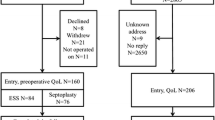Abstract
Evaluation of the severity of disease and the effectiveness of operative treatment is commonly done by registering pre- and postoperative symptoms. During the preceding decade, greater awareness has focused not only on the symptoms but also on patients’ quality of life (QoL). The aim of the study was to determine the effect of septoplasty, as measured by generic and disease-specific QoL questionnaires. The generic 15D and disease-specific SNOT-22 questionnaires were given to patients before the operation and 6 months after the operation. Data analysis consisted originally of 188 septoplasty patients. One-hundred and twenty-six patients (67%) answered the SNOT-22 questions, and in the 15D, the response rate was 76%. In the post-operative SNOT-22, the need to blow the nose, sneezing, runny nose, nasal obstruction, loss of smell or taste, post-nasal discharge, facial pain/pressure, difficulty in falling asleep and waking up at night improved significantly. However in the 15D the mean QoL, i.e., general well-being, became significantly poorer. The QoL became increasingly poor especially in the older age groups and among the patients in which the improvement achieved in nasal symptoms postoperatively was minor. The more nasal symptoms the patients had pre- or postoperatively, the poorer the QoL was in general. Based on our results, critical evaluation of the symptoms and findings in the patients is essential in deciding whether surgery or other treatment should be given to individual patients having nasal blockage symptoms. Especially in patients with mild symptoms or among older patients, adequate medical treatment has to be tried before even considering surgery. The results also encourage the use of a systematic questionnaire to estimate the severity of symptoms in daily clinical practice.




Similar content being viewed by others
References
van Olphen AF (2008) The septum. In: Scott–Brown’s otorhinolaryngology. Head Neck Surg 2:1582–1588
Hytönen M, Blomgren K, Lilja M et al (2006) How we do it: septoplasties under local anaesthetic are suitable for short stay surgery; the clinical outcomes. Clin Otolaryngol 31(1):64–68
Jessen M, Ivarsson A, Malm L (1989) Nasal airway resistance and symptoms after functional septoplasty: comparison of findings at 9 months and 9 years. Clin Otolaryngol Allied Sci 14(3):231–234
van Oene CM, van Reij EJ, Sprangers MA et al (2007) Quality-assessment of disease-specific quality of life questionnaires for rhinitis and rhinosinusitis: a systematic review. Allergy 62(12):1359–1371
Arunachalam PS, Kitcher E, Gray J et al (2001) Nasal septal surgery: evaluation of symptomatic and general health outcomes. Clin Otolaryngol Allied Sci 26(5):367–370
Stewart MG, Smith TL, Weaver EM et al (2004) Outcomes after nasal septoplasty: results from the nasal obstruction septoplasty effectiveness (NOSE) study. Otolaryngol Head Neck Surg 130(3):283–290
Gandomi B, Bayat A, Kazemei T (2010) Outcomes of septoplasty in young adults: the nasal obstruction septoplasty effectiveness study. Am J Otolaryngol 31(3):189–192
Calder NJ, Swan IR (2007) Outcomes of septal surgery. J Laryngol Otol 121(11):1060–1063
Siegel NS, Gliklich RE, Taghizadeh F et al (2000) Outcomes of septoplasty. Otolaryngol Head Neck Surg 122(2):228–232
Croy I, Hummel T, Pade A et al (2010) Quality of life following nasal surgery. Laryngoscope 120(4):826–831
Lilja M, Mäkitie AA, Anttila VJ et al (2011) Cefuroxime as a prophylactic preoperative antibiotic in septoplasty: a double blind randomized placebo controlled study. Rhinology 49:58–63
Sintonen H (1994) The 15D-measure of health-related quality of life: I. Reliability, validity and sensitivity of its health state descriptive system. National Centre for Health Program Evaluation, Melbourne (Working Paper 41)
Sintonen H (1995) The 15-D measure of health-related quality of life: II feasibility, reliability and validity of its valuation system. Working Paper 42. National Center for Health Program Evaluation. National Health and Medical Research Council. Melbourne (http://www.buseco.monash.edu.au/centres/che/pubs/wp42.pdf)
Stavem K (1999) Reliability, validity and responsiveness of two multiattribute utility measures in patients with chronic obstructive pulmonary disease. Qual Life Res 8:45–54
Hawthorne G, Richardson J, Day NA (2001) A comparison of the assessment of quality of life (AQoL) with four other generic utility instruments. Ann Med 33:358–370
Sintonen H (2001) The 15D instrument of health-related quality of life: properties and applications. Ann Med 33:328–336
Moock J, Kohlmann T (2008) Comparing preference-based quality-of-life measures: results from rehabilitation patients with musculoskeletal, cardiovascular, or psychosomatic disorders. Qual Life Res 17:485–495
Petersen KD, Kronborg C, Gyrd-Hansen D et al (2008) Quality of life if rhinoconjuctivitis. Allergy 63:284–291
Aromaa A, Koskinen S (2004) Health and functional capacity in Finland. Baseline results of the Health 2000 health examination survey. Publ Natl Public Health Inst Series B 127:171
Hopkins C, Gillett S, Slack R et al (2009) Psychometric validity of the 22-item Sinonasal Outcome Test. Clin Otolaryngol 34(5):447–454
Buckland JR, Thomas S, Harries PG (2003) Can the Sino-nasal Outcome Test (SNOT-22) be used as a reliable outcome measure for successful septal surgery? Clin Otolaryngol Allied Sci 28(1):43–47
Gillett S, Hopkins C, Slack R et al (2009) A pilot study of the SNOT 22 score in adults with no sinonasal disease. Clin Otolaryngol 34(5):467–469
Busaba NY, Hossain M (2004) Clinical outcomes of septoplasty and inferior turbinate reduction in the geriatric veterans’ population. Am J Rhinol 18(6):343–347
Samad I, Stevens HE, Maloney A (1992) The efficacy of nasal septal surgery. J Otolaryngol 21(2):88–91
Pirilä T, Tikanto J (2009) Acoustic rhinometry and rhinomanometry in the preoperative screening of septal surgery patients. Am J Rhinol Allergy 23:605–609
Hytönen ML, Bäck LJJ, Malmivaara AV et al (2009) Radiofrequency thermal ablation for patients with nasal symptoms: a systematic review of effectiveness and complications. Eur Arch Otorhinolaryngol 266(8):1257–1266
Acknowledgments
We thank Timo Pessi for doing the statistics. We also thank the Department of Otorhinolaryngology’s Research Funds for financial support.
Conflict of interest
None of the authors have any commercial association that might pose a conflict of interest.
Author information
Authors and Affiliations
Corresponding author
Rights and permissions
About this article
Cite this article
Hytönen, M.L., Lilja, M., Mäkitie, A.A. et al. Does septoplasty enhance the quality of life in patients?. Eur Arch Otorhinolaryngol 269, 2497–2503 (2012). https://doi.org/10.1007/s00405-012-1931-9
Received:
Accepted:
Published:
Issue Date:
DOI: https://doi.org/10.1007/s00405-012-1931-9




